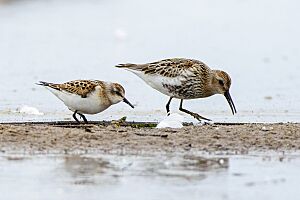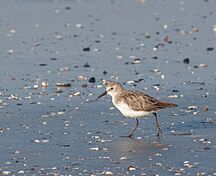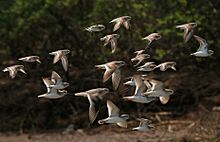Little stint facts for kids
Quick facts for kids Little stint |
|
|---|---|
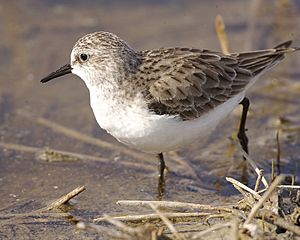 |
|
| Non-breeding adult in Egypt | |
| Conservation status | |
| Scientific classification | |
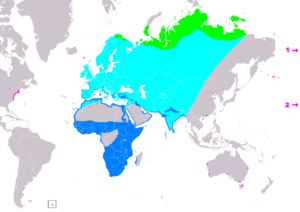 |
|
| Range of C. minuta Breeding Passage Non-breeding Vagrant (seasonality uncertain) | |
| Synonyms | |
|
Erolia minuta |
The little stint (Calidris minuta) is a very small wader, which is a type of bird that wades in shallow water. It breeds in the cold northern parts of Europe and Asia. This bird is a long-distance migrant, meaning it travels very far. It spends its winters in Africa and southern Asia. Sometimes, it can even be seen in places it doesn't usually live, like North America and Australia. Its scientific name, Calidris minuta, comes from old Greek and Latin words. Calidris was a name for grey waterside birds, and minuta means "small."
Contents
What Does a Little Stint Look Like?
The little stint is a very small bird. You can tell it apart from other similar birds by its thin dark beak, dark legs, and how quickly it moves. It also has toes that aren't webbed (like a duck's), and its wingtips stick out quite a bit when folded. When it calls, it makes a sharp "stit" sound.
When breeding, adult little stints have an orange tint on their chest, a white throat, and a clear white V-shape on their back. In winter, their feathers look different, and it can be harder to identify them. Young little stints have pale stripes on their heads and a pinkish chest.
Sometimes, a little stint might even breed with a Temminck's stint. A bird that was a mix of these two species was once seen in the Netherlands.
Little Stint Populations
The number of little stints (and curlew sandpipers) can change depending on how many lemmings there are. Lemmings are small rodents that live in the Arctic. In years when there aren't many lemmings, predators like skuas and snowy owls might hunt these birds instead.
In winter, little stints like to be in groups. They often form big flocks with other similar birds, especially dunlins. You can find these flocks on muddy coasts or near inland ponds.
The little stint is one of the birds protected by an important agreement called the Agreement on the Conservation of African-Eurasian Migratory Waterbirds (AEWA). This agreement helps protect birds that migrate across Africa and Eurasia.
Reproduction and Nesting
Little stints make their nests on the bare ground. They create a small dip in the dirt, called a scrape. Each nest usually has 3 to 5 eggs. These birds are polygamous, which means one male or female might mate with more than one partner. Both male and female birds might take turns sitting on different clutches of eggs to keep them warm.
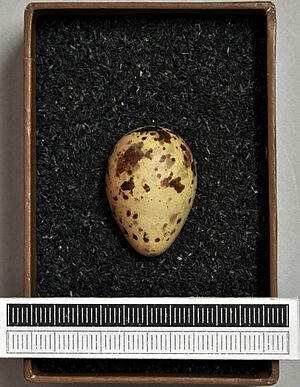
What Do Little Stints Eat?
Little stints eat small invertebrates. They pick these tiny creatures off the mud where they wade.
Gallery
-
Little stint, non breeding in February, Vasai, Maharashtra, India.
-
Mixed flock with the larger Terek sandpiper in Andhra Pradesh, India.



